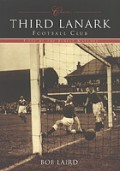|
With the news that the name of Third Lanark is up for sale on ebay that would certainly have been of interest to one Glasgow Accie if he had been alive today
H.E.Crum- Ewing who was the first President of the Glasgow Academical Club when it was formed in 1866 was also a founding father for Third Lanark the mighty Hi-Hi
Maybe it was through his influence that one of the early Inter City rugby matches was played at Cathkin Park.
Third Lanark played at Cathkin Park. This was previously known as Hampden Park (the second of three grounds to bear this name) before Queen's Park sold it to Third Lanark and moved to a new stadium of the same name. Cathkin Park is currently owned by Glasgow City Council, and remains of the terracing can still be seen
Read on
3rd Lanarkshire Rifle Volunteers Football Club
Third Lanark FC are unique in the annals of Scottish if not British football as they were borne from the 3rd Regiment of the Lanarkshire Rifle Volunteers in 1872.
Volunteer forces were raised during the Napoleonic Wars but most were disbanded after the French defeat at Waterloo in 1815.
French naval expansion in the 1850's caused 'invasion panic' and in 1859 Volunteer Corps were re-created. Members of the corps received no pay and provided their own uniforms and equipment.
The Lanarkshire Volunteers were made up of the 1st, 2nd, 3rd and 4th Corps with the 3rd based in the Strathbungo area in the south side of Glasgow.
The 3rd Lanarkshire Corp was made up by the amalgamation of several independent units including the '8th Coy Etna Foundry' and the remainder of the '78th Corps Old Guard of Glasgow.'
Their increasing 'professionalism' was confirmed in the Volunteers Act of 1863 by which time the Volunteers could now be called out for active military service instead of being utilised solely for defence purposes.
The first Scotland v England football international at Hamilton Crescent, Glasgow in 1872 inspired the regiment to start a football team of their own, subsequently becoming one of the original members of the Scottish Football Association.
A meeting was duly advised by the intimation of a public notice on the 12th December 1872 by members of the 3rd Lanarkshire Rifle Volunteers and the meeting was convened in the Regimental Orderly room in East Howard Street, Glasgow.
Private Broadfoot explained that the meeting was called for the purpose of organising, if possible, a Football Club in connection with the Third Regiment. He further reported that Lieutenant-Colonel H E Crum-Ewing, the majority of the Officers and twenty-five other members of the Regiment had signified their willingness to support such a club.
Sergeant Wilson then moved: "That we, the Members now assembled should form ourselves into a club, to be called the 3rd Lanark Rifle Volunteers Football Club."
The motion was seconded by Private Taylor, and unanimously approved of.
First to be debated was the 'uniform,' which was to consist of:
1) A scarlet Guernsey or Jersey (the colour of the regiment uniform)
2) Blue trousers or knickerbockers
3) Blue stockings
A subsequent meeting decreed that the number 3 should be displayed on the Guernsey.
The first playing field of the team was the Regimental drill ground at Victoria Road, Glasgow which was situated just to the south of the Regimental Headquarters, with occasional indoor training at Regimental drill hall in Coplaw Street, Govanhill, before ultimately moving to a 'new' ground, Old Cathkin Park in 1875.
The ground was offered to the team by the then owners 'Dixons' which was a well known ironworks in Cathcart Road, Glasgow and after making the surface playable goalposts and crossbars (as opposed to tapes) were erected.
A grandstand was built in 1878 with the ultimate accolade coming, for all the subsequent hard work carried out in developing the ground, when in 1884 Old Cathkin Park was chosen as the venue for the then annual Scotland v England match resulting in a 1-0 win for Scotland which was their 5th win in a row against the 'Auld Enemy'.
The team was enjoying a particularly successful period at this time and in 1885 recorded their highest ever score defeating St. Andrews 11-0 in a 3rd round Scottish Cup match ,a score line which was to remain unsurpassed throughout their illustrious history.
In May 1881, there was a major reorganisation in the British army. Regiments ceased to be numbered and instead took names associated with their recruiting area or an element of their history.
The Volunteer Corps were now linked with the regular army and the four Lanarkshire Rifle Volunteer Corps became the 1st, 2nd, 3rd and 4th Volunteer Battalions attached to the Cameronians (Scottish Rifles).
This article was originally posted on 22-Feb-2007, 08:31 by Hugh Barrow.
Last updated by Hugh Barrow on 22-Feb-2007, 08:44.
|








